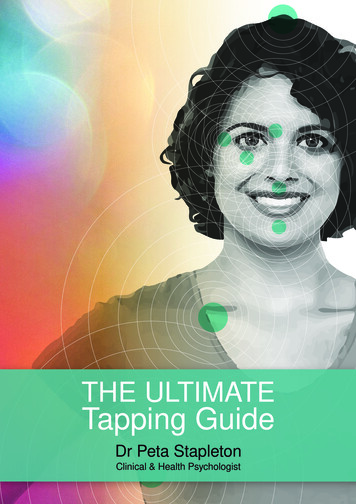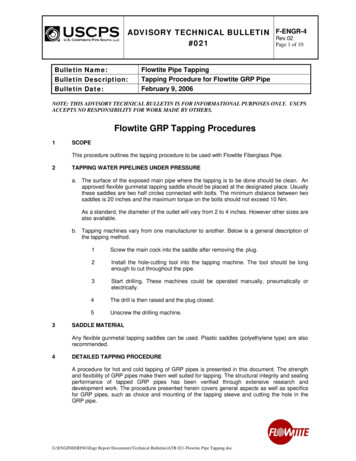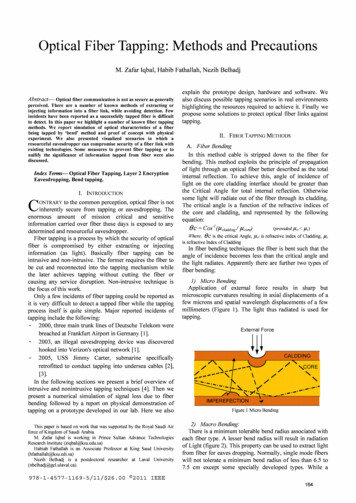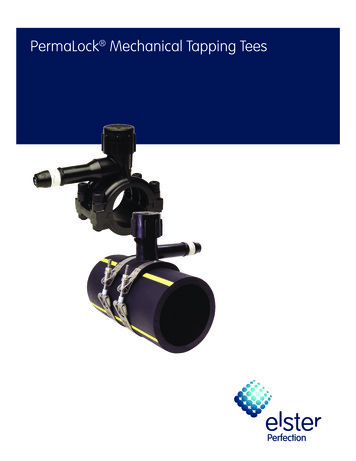
Transcription
THE ULTIMATETapping GuideDr Peta StapletonClinical & Health Psychologist
THE ULTIMATETapping GuideDr Peta StapletonClinical & Health PsychologistCopyright 2019 by Peta StapletonAll rights reserved. No part of this book may be reproduced by any mechanical, photographic, or electronic process, orin the form of a phonographic recording; nor may it be stored in a retrieval system, transmitted, or otherwise copied forpublic or private use—other than for “fair use” as brief quotations embodied in articles and reviews—without prior writtenpermission of the publisher.The author of this book does not dispense medical advice or prescribe the use of any technique as a form of treatmentfor physical, emotional, or medical problems without the advice of a physician, either directly or indirectly. The intent ofthe author is only to offer information of a general nature to help you in your quest for emotional, physical, and spiritualwell-being. In the event you use any of the information in this book for yourself, the author and the publisher assumeno responsibility for your actions.iThe Ultimate Tapping Guide 2019 Dr Peta Stapleton
Author’s NoteAlthough they are gaining in scientific support, Emotional Freedom Techniques (EFT) and “tapping”are still considered experimental in nature. All information, books, workshops, and trainings areintended to promote awareness of the benefits of learning and applying EFT. However, the generalpublic must take full responsibility for their use of it. The material in this book is for your generalknowledge only and is not a substitute for traditional medical attention, counseling, therapy, oradvice from a qualified health-care professional.Neither EFT nor the information here is intended to be used to diagnose, treat, cure, or preventany disease or disorder. Please note that if you begin tapping and find yourself overwhelmed,distressed, or becoming aware of previously forgotten memories, you may need to seek theprofessional help of a trained and experienced EFT practitioner.A lack of results or progress may also mean you need professional assistance. If you have anyconcern regarding your health or mental state, it is recommended that you seek out advice ortreatment from a qualified, licensed health-care professional. Before making any changes to yourdiet, medication, or health plan, it is recommended that you first consult with a doctor, pharmacist,or other qualified medical or health professional.iiThe Ultimate Tapping Guide 2019 Dr Peta Stapleton
What is EFT?While EFT can address a range of complex emotional challenges, the basic protocol is quitestraightforward and surprisingly easy to learn. It instructs you on only two activities: what you sayor think and where you tap. It is a powerful way to come to terms with unresolved childhood issues,change unwanted responses to various emotional triggers, transform beliefs that do not serve you,and reprogram yourself for greater happiness and success.What you say or think during an EFT session involves an ever-shifting focus on (1) your initialconcern, (2) its roots in your history, (3) the feelings and sensations it creates in your body, and (4)self-suggestions or affirmations about what you want to change.Where you tap is based on the ancient system of acupuncture. Certain acupoints (areas importantin acupuncture) have been shown to have a powerful impact on the way the brain responds tostress and the way it processes information.Note that the technique outlined in this guide represents Clinical EFT. This is the version mostlytested in research trials. (Researchers worldwide tend to only use Clinical EFT in their trials,because it is only in establishing evidence for the original protocol that we can then extend it tobriefer or adapted versions.)HOW TO TAPAcupoints on the face and upper body are stimulated in EFT by tapping on them with two fingers;usually the index and middle fingers. The amount of force used while tapping should be firm yetalways comfortable. You may feel a resonance spreading out across the adjacent area of your bodyfrom the point you are tapping, but even if you don’t feel it, it is still occurring. Some instructionssuggest that you should tap on each spot about seven times before moving on to the next, but youdon’t need to count since you will tap for as long as it takes to say the statement you formulate ateach point.Tapping can be used to change distressing or negative feelings and self-limiting thoughts orbehaviors as well as to instill more positive emotional states, beliefs, or goals. Typically, youclear any distressing or negative aspects with tapping before using it to open up more positivepossibilities in that area.1The Ultimate Tapping Guide 2019 Dr Peta Stapleton
THE STEPSHere are the five basic steps of EFT: First recognize what you wish to change and rate your distress/discomfort about this areaof your life on a scale of 0 to 10 (10: extreme distress; 0: no distress). This is called the“subjective units of distress” (SUD) rating. It is an internal assessment about the intensity ofyour feelings around the problem, and it is fine if it just feels like a guess. Your intuition willguide you. The aim is to tap until you feel calmer about the issue, and usually the number willgo down to 0 or 1. You can also stop with a higher SUD rating if the shift you have achievedfeels like enough for that particular EFT session. Next you capture the problem in a setup statement (see the next section), which you statewhile tapping on the side-of-the-hand point (see Figure 1A). While you can state it in yourmind, you may be more likely to drift in your thoughts. Plus saying it out loud engages youmore fully with the statement. Next tap through all eight EFT points on the face and upper body (see Figure 1B) whilesaying a short reminder phrase to keep your mind engaged. This is usually a word or briefphrase that describes your feeling in relation to the setup statement. Tapping on the eightpoints is called a round in EFT. Take a breath and re-rate your distress between 0 and 10 on the SUD scale. Remember thiscan be a subjective, intuitive guess. It is better to use the first number that comes into yourmind than to ponder it too long. Keep tapping through additional rounds (using the face and upper body points) until the SUDrating is quite low, a 1 or 0.Tapping Points8. Top of Head1. Start ofEyebrow2. Side of Eye3. Under Eye4. Under Nose5. Chin6. Collarbone7. Under Arm4 inchesFigure 1A (above): Tapping pointon side of handFigure 1B (right): The eight EFTpoints on the face and upper bodyIf you would like to watch a video of Peta teaching tapping and outlining how it works.Go here – https://www.youtube.com/watch?v lDSh6LtD68k&t 11s2The Ultimate Tapping Guide 2019 Dr Peta Stapleton
THE SETUP STATEMENTA typical setup statement might be: “Even though I [insert your feeling/issue here], I deeply andcompletely accept myself.” You say this three times while tapping on the side-of-the-hand point.There is a saying in psychotherapy that you can’t change a personal quality unless you first acceptit, and this pairing of your problem with an acceptance statement helps build that self-acceptance.Because you are focusing on your feeling, the setup statement keeps you in the present moment.While you can change the ending of the setup statement, it should accomplish two things: State the actual problem or feeling. Express acceptance that this is how you currently feel—right now (even though you areaiming to change the feeling or the situation that evokes the feeling).With that in mind, you could say any of the following at the end of the setup statement: Even though I , I accept I have this problem.Even though I , I am still a good person.Even though I , I am taking charge right now.Even though I , I want to change this.Even though I , I completely and sincerely accept myself.Even though I , I completely love/like and accept myself.Even though I , I deeply and completely love and accept myself anyway.Even though I , I deeply and completely forgive myself.Even though I , I deeply and completely love and accept my feelings.Even though I , I choose to love and accept myself.Even though I , I choose to be open to this process.Even though I , I am okay and open to the process.Even though I , right here right now, I am safe.In brief, the opening part of the setup statement includes a short description of the problem or yourfeelings about it. Then, in the second part, you are giving yourself an affirmation or self-suggestionthat you recognize and accept what is. This focus on “what is” is a feature of mindfulness, whichhas proven to be a highly effective practice when introduced into the therapy setting. Meanwhile,tapping on the acupoints helps calm the brain, making it even easier to stay in the present moment.The emphasis on accepting the problem and your feelings about it may seem counterintuitive.You might wonder, Why not just focus on the desired changes? However, self-help and therapeuticapproaches that begin by “attacking” the problem or one’s patterns of thought and emotion tend tobring up inner resistance that undermines the approach.Using “I Choose” StatementsDr. Patricia Carrington pioneered the “I choose” statements to help make the beneficial changesfrom EFT to become permanent and generalize to many aspects of your life.1 Try this by adding“I choose” to the end of the setup statement. Here are examples of how this is included: “Even though I feel my mother never loved me, I choose to love myself anyway.” “Even though I feel deprived when I don’t have chocolate, I choose to be fit and healthy.” “Even though I’m nervous about giving that talk on Tuesday, I choose to be calmand confident.”3The Ultimate Tapping Guide 2019 Dr Peta Stapleton
SO WHY DO WE STATE THE NEGATIVE?This is a common question as many therapies seek to reframe a person’s issue, or simply learnto accept it. Tapping doesn’t affirm or implant a problem; however, on the surface it may look likethat. The process does have someone state the truth of what is happening for him or her andacknowledge it. We are actually engaging the amygdala (stress center) and the limbic system(emotions) in the brain and body with this technique.It is as though we are engaging these negative feelings or sensations just long enough to feel them,then we hit the delete button through the tapping.It is the tapping process that calms the physiological response from the body. Once this is released,cognitive shifts (or reframes) may surface naturally.If we tap with a positive affirmation first (attempting to take our mind off our problem), it may onlyresult in a minor shift. It is like spraying air freshener when the garbage is still there. We need to tapon the real problem and reduce the intensity before tapping on anything positive.The key in EFT is to actually do the tapping when you acknowledge your problem and state it outloud. It is the somatic aspect that changes the response, not just stating your problem. There havebeen several dismantling studies of EFT done, often by researchers who do not use the techniqueat all. Basically we now know that the tapping aspect is a key active ingredient in the processworking—and just stating your problem with an acceptance element may not result in it changing.REMINDER PHRASEThe short reminder phrase you say as you tap on each acupoint captures the main feeling ornegative state you want to change (e.g., “angry” or “sad”).Suppose you will be giving a talk next week, and you are nervous about it. To apply EFT, you wouldstart with a setup statement such as this:“Even though I’m feeling anxious and nervous about the talk I have to give, I accept this is howI feel right now.”Your reminder phrase could be “nervous” or “anxious.” This is the feeling you would initially rate onits intensity from 0 to 10, and then rate again after each round of tapping. This gives you instantfeedback about what is happening as a result of that tapping round.You will usually find that the SUD rating has gone down, but occasionally it will have increased.This generally means you have tuned in to the problem more deeply rather than that tapping hasn’tworked. When this occurs, the true SUD was always the higher number, and you continue fromthere.Ideally you should keep tapping as long as your SUD rating is still more than 1. You can adjustthe reminder phrase if you think of a better description as you tap. For instance, you might startby using “angry” as your main feeling, but after a few rounds of tapping, you may realize the feelingis now disappointment. So “disappointed” would become your reminder phrase.4The Ultimate Tapping Guide 2019 Dr Peta Stapleton
EXAMPLE – TAPPING FOR STRESSAlways remember to be specific to your own physical sensation, words to describe your situationor feelings/ thoughts. Tapping works best when you are VERY SPECIFIC.If you are feeling stressed right now (or have recently) think about how it makes you FEEL. If youcan feel it in your body, where is that? If it is in your stomach, solar plexus area, head – write thatdown:What do you TELL YOURSELF when you feel stressed? What thoughts are in your head(e.g. I can’t cope, I am overwhelmed, There is so much to do). Write these down:Write the level of intensity on the ideas above out of 10.10 most distress/feeling/sensation and 0 completely calm.Now let’s tap.While tapping the side of the hand point (on either hand), repeat these phrases out loud,(or change the words to fit your exact situation).“Even though I feel completely overwhelmed at the moment, I accept myself anyway.”“Even though I feel stressed with the thought of everything I have to do, I accept how I feel.”“Even though I feel sad, depressed, lonely, overwhelmed, tired, exhausted ., I accept thisis how I feel right now.”Now for the reminder phrasesTap through each of the points from the image:Eyebrow: “I feel so tired”Side of Eye: “I’m feeling overwhelmed.”Under Eye: “I feel angry.”Nose: “I feel stressed.”Chin: “This is overwhelming.”Collarbone: “I am SO exhausted.”Under Arm: “I feel so much resistance.”Head: “I don’t know how to change all of this.”Tap around and see how your body feels after a few rounds. Try and identify areas that might beholding tension, emotions or overwhelm. Keep tapping until you are a 0 or a 1 out of 10 (10 beingthe most overwhelm, and 0 being complete calm). Write down your notes to check in later.5The Ultimate Tapping Guide 2019 Dr Peta Stapleton
2 Ways to use Tapping for Feeling Stressed1. You can tap just to calm down in the moment – when you feel stressed, just tap on thephysical sensations (e.g. headache, tight in chest, stomach) to introduce some calm. You cansimply tap and breathe (tap on each point but just say the words ‘breathe’ or ‘relax’ as youtap – this is to just introduce a physiological calm, rather than address any problem). You maythen be in a position to start tapping on what is actually happening to make you respond inthat moment with a stressed feeling.2. Use tapping to explore WHY you react in certain ways with stress. Have a think about earliermemories in your life when you may have felt stressed, in order to track the pattern of WHENit started. You may have learnt your coping skills by watching others (e.g. parents) or becauseyou were too young and didn’t have the skills developed yet. You can tap on youngermemories with the Movie Technique in EFT or Matrix Reimprinting.Always seek the support of a professional and skilled EFT practitioner if you need supportwith this.EXAMPLE – TAPPING FOR A HEADACHEHere is how I might proceed through a session of tapping if I had a headache.First, I recognize my headache and rate the throbbing pain as a 9 out of 10 on the SUD scale.I then tap on the side of my hand with two fingers of the other hand (see Figure 1A) whilesaying, “Even though I have this headache in both temples and feel sick, I accept that I have thisheadache.” I do this three times while tapping on the side-of-the-hand point.Then I would start tapping through the eight points (see Figure 1B) and say, “This headache” or“I feel sick.” I could also use descriptive words, such as “throbbing pain.”I would repeat the rounds of tapping until I felt a shift or difference, usually indicated by a low SUDnumber. Then the session would be complete.POSITIVE TAPPINGAlthough most people tap only when they discover a negative feeling they would like to reduceor change, you can use tapping for positive statements. Do this only after you have reduced anynegative feelings associated with a memory, thought, or feeling. You can then do rounds of positivetapping to introduce any new feeling or belief you would like to have.For example, after you tap on feeling nervous about the speech next week, you could do a round oftapping on “Even though I was really nervous about giving that talk next week, I now feel calm andconfident.” (You might then use “calm and confident” as your reminder phrase.)After you have tapped to reduce a headache, you could do a round of tapping on “Even thoughI have had that headache for days, I now feel clear and focused.” (Reminder phrase is “clearand focused.”)6The Ultimate Tapping Guide 2019 Dr Peta Stapleton
SO HOW DOES EFT WORK?EFT appears to affect the amygdala (stress center in the brain) and hippocampus (memorycenter), both of which play a role in the decision process when you decide whether somethingis a threat. EFT has also been shown to lower cortisol levels, which is the stress hormone.Too much cortisol can result in lowered immune function and ultimately affect our physicalhealth (e.g., fatigue illnesses).Stimulation of acupoints like those used in EFT is believed to send a signal to the limbic or emotionsystem in the body and reduce its arousal.2 This is why you tend to feel calmer after tapping. It isalso why some people yawn while tapping!EFT can also decrease activity in the amygdala, which is part of the brain’s arousal pathway.3And studies with long-term follow-up points are showing the changes last over time, so theremay be changes in the brain’s neural pathways4 over time.So, ultimately, we have this stress-management tool—a way of calming the body and brain.This may then allow for clearer thoughts and better decision making.THE IMPORTANCE OF BEING SPECIFICTapping works best when you are very specific. Tapping on great big global statements suchas “I always run late” may not result in much change to your behavior. It is better to pick exactmemories of running late and tap on what happened and how you felt.Pick the earliest possible memory you have, as this may be closer to the origin of the behavior/pattern. You can also try to remember ever learning a behavior/pattern when you were quite young(e.g., by watching a family member). You may have feelings/beliefs that you adopted by watchingsomeone else, rather than ever experiencing it yourself (the mirror neuron section below explainswhy this might happen). You can still tap on those times where you learned a pattern or behaviorby watching someone else.7The Ultimate Tapping Guide 2019 Dr Peta Stapleton
ASPECTSWhen we tap on a situation, event, or memory that has caused us some distress, we often look foraspects. These are the parts of an event or memory that can include sounds, taste, smell, feelings,physical sensations, and thoughts or beliefs. Each event may not have all of these present, but itis important to look for them while tapping.A fear of flying may include the following aspects: The fear of turbulence or loss of control The fear of aircraft or pilot failure The fear of terrorism The fear of tight spaces (claustrophobia) The fear of heights The fear of the unknown A past memory of flying where something went wrong Family stories of other people flying where something went wrong Physical anxiousness and other body sensations Blank mind or dazed thinking Emotions of terror and intense fear and thoughts of deathA food craving could also have many aspects: Smell of the food Taste of the food in your mouth Feeling in body/mouth as you eat the food (e.g., salivation) Past memories of that food or something similar General memories of food that are very positive and emotional Sight/vision of that food Sound of food when unwrapping itAs described, aspects could be a thought, a feeling, a body sensation, a sound, a smell, andanything else you think of. We think of them as jigsaw puzzle pieces that all come together to makeup a state or memory. In a distressing moment, they tend to all blend together, and it can becomeharder to remember what actually happened.However, tapping does help tease them apart, and sometimes you begin to become aware ofdifferent aspects while tapping. When someone smells something in their current life or hearsa sound and is transported back in time to a memory, this might be an aspect from that originalmemory. They can have the same feelings now in their present moment as they did back then.The trigger for that smell or sound transports someone back in time, because it was stored asan aspect a long time ago.Many aspects may need to be tapped on for an issue to be resolved. However, it may not takethat long. EFT can work so quickly that it takes your breath away.8The Ultimate Tapping Guide 2019 Dr Peta Stapleton
TABLETOPS AND TABLE LEGSWe often use an analogy of a table when discussing how EFT can work quickly. The tabletop inthe analogy often represents a global issue in life, and the legs of the table represent the timesin life that reinforced that issue. Each of the legs and memories will have its own aspects.Let’s consider a common pattern of behavior: procrastination. Imagine someone who just doesthis all the time. Even when they try to be organized and efficient, they slip into a pattern ofprocrastinating.In this example the tabletop is procrastination. It is the big global issue, and tapping just on“procrastination” may not change the behavior. The legs of the table are the events, memories,and times in that person’s life where they did procrastinate; and some of these will be moresignificant that others (e.g., if there was a negative consequence from procrastinating, it may havebeen more impactful).Tapping on all those specific events with all the aspects will be important. However, you may nothave to tap on every single time in your life you ever procrastinated. (You may sigh in relief here!)It only appears important to tap on the really significant memories you recall about the topic.The procrastination table here will collapse when the largest legs are removed. The table will fallover even when several legs remain.Figure 1C offers a visual example of a tabletop of someone who believes they aren’t good enough.You can see the legs of the table include examples of specific times in their life where they haven’tmeasured up (and each of these can have its own legs too). The idea is to tap on these individualmemories (legs) as you become aware of them, and over time the belief of “I am not good enough”will change, and you will have a different reality. Chances are, you won’t have to tap on everysingle memory.Table Tops and Table Legs ExampleFigure 1C: Tabletop and table legs exampleCore Belief I am not good enoughI will never be good enoughThat time whenI was 15 years oldwhen I didn’t geta rose at schoolfor Valentine’s DayWhen dad used to yellat me “What’s wrongwith you?” whenI made a mistakeThat time whenI was 7 years oldwhen I didn’t getthe star of the dayaward in classThat time my boss saidI wasn’t up to scratch inmy performance reviewand had roomfor improvementWhen mum laughed atme during the dancerecital becauseI couldn’t get itWhen mum used torip up my homeworkbecause it wasn’tgood enoughWhen I didn’t havethe same brand shoesas everyone becausewe couldn’t afford itWhen the Yr 10coordinator saidI couldn’t studymusic becauseI hadn’t done itas a prerequisiteThat time whenI was 22 years oldwhen I gotoverlooked for thepromotion at work9The Ultimate Tapping Guide 2019 Dr Peta Stapleton
IDEAS FOR TAPPING WHEN YOU THINK OF A MEMORY: THE MOVIE TECHNIQUEThe importance of past memories and events in tapping is becoming clear. They form part of theexperience you currently have. So we do look for them while tapping. You may be aware of themat the start of tapping, but other times as you are tapping, a fleeting thought passes through yourmind, sometimes related, sometimes unrelated. Often this is part of your unconscious mind lettingyou know about a memory that may be important.The process outlined next is called the Movie Technique and is one way to use tapping for pastmemories. Here are the steps. Imagine the movie or memory and first give it a title. Make this title something fairly neutralsuch as “The Day That Thing Happened.” This allows you to have some distance from it ifit is distressing. Then give the movie title a SUD rating out of 10 (10: most distress, and 0:complete calm or neutral). Tap with the standard technique just for that SUD on the movietitle until it feels lower in intensity before moving to step two. After the SUD rating on the title of the memory feels like a 0 or 1, you are going to beginthinking about that past event as a movie. You can close your eyes for this or keep them openif you prefer to just stare at a spot ahead as you imagine in your mind’s eye. You will want toimagine the memory is on a movie screen and you are watching it from the seats, or even theprojection box, in a movie theater. It is important that you are watching yourself in the movieat a younger age. At no point are you in the movie yourself — you are always watching it froma distance. Chose a neutral point in time to be the starting point for the movie, before anythinghappened in the memory. This might be an hour before it happened, or even the day prior. Play the movie memory very slowly from the neutral point, and stop the movie when you noticeany negative or distressing sensation, thought, or anything else comes up. At this point freezethe movie and give that intensity a SUD rating out of 10. You might open your eyes at this point. Use the standard steps: say your setup statement for that feeling, and tap until the SUD ratingis a 0 or 1. When you feel calm for that first feeling, close your eyes again and rewind themovie memory to the beginning. Play it from the neutral start point in your mind, and checkif that initial feeling is still low in intensity. If it is, continue playing the movie until you noticeanother concern. Remember this could be a thought, feeling, or body sensation. Stop themovie and do the same process as above. Rate the level of intensity out of 10, form a setupstatement, and tap through the points for as many rounds as you need until the intensityis a 0 or 1. If the first feeling you tapped on still seems high on the SUD scale when youcheck the movie, continue to tap on that before moving forward in the movie. Sometimesthere is a different aspect that needs to be addressed before you feel truly calm. Continue the same process of stopping the movie when you notice any intensity, using a setupstatement to acknowledge it, and tapping through the eight points until the SUD is a 0 or 1.Eventually, you will be able to watch the whole movie in the theater, in your mind’s eye, and feelneutral or calm about it. Sometimes people describe feeling more distance between themselvesand the movie, and while it still happened in the past, they have more perspective now.The Movie Technique doesn’t change that the memory happened to you — but it does releaseany emotional charge that still might be in there.If you feel distressed while doing this technique, the important thing is to keep tapping. It is thetapping process that calms the limbic system and will help you feel relaxed (and stop crying).However, if distressing memories come to mind and are overwhelming, it is always strongly recommendedyou engage with a professionally trained EFT practitioner to support you in processing them.10The Ultimate Tapping Guide 2019 Dr Peta Stapleton
WHY SOMATIC BODY BASED APPROACHES MIGHT BE THE 4TH WAVEI believe EFT enjoys three features that distinguish it as a fourth-wave therapy: It is a true mindbody approach in that it includes direct interventions at the level of the body; it changes brainactivity very rapidly; and it has special advantages in quickly and permanently shifting outdatedemotional learnings. A Somatic Intervention. Therapists who are effective in working with people who have beentraumatized have long recognized that talk therapies are not enough for healing the damagethat is caused by abuse and catastrophe. The title of an influential paper and subsequentbook, The Body Keeps the Score, by Dr. Bessel van der Kolk underlines this point. Thephysiological changes to the body and brain following trauma become “encoded in theviscera” and require treatments that “engage the safety system of the brain before trying topromote new ways of thinking.” Effective therapies for severe trauma must address the bodyas well as the mind, and being able to do so is a great strength of somatic therapies.It is not just tapping on the skin that makes EFT a somatic intervention. Tapping initiatesa cascading series of events in the brain and body that, as you will see below, impacthormone production, brain waves, blood flow within the brain, and gene expression in waysthat enhance emotional health. And tapping has this impact not just for treating trauma butalso in addressing everyday anxieties, upsets, and goals. Rapid Results. A decade-long research program at Harvard Medical School looking at whathappens in the body when various acupoints are stimulated found that certain points almostinstantly decrease the activation of the stress response in the bra
Keep tapping through additional rounds (using the face and upper body points) until the SUD rating is quite low, a 1 or 0. Figure 1A (above): Tapping point on side of hand Figure 1B (right): The eight EFT points on the face and upper body Tapping Points Start of Eyebrow Under Eye Side of










